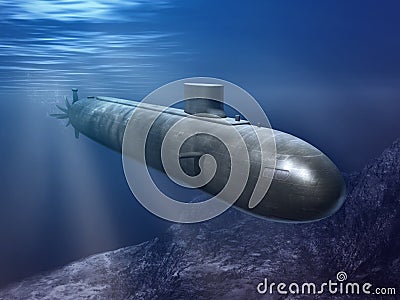

Sound is everything under the sea and billions have been invested into acoustic properties that will muffle a submarine’s engine, as well as in better hull designs which allow water to flow more quietly over the sub’s surface. Able to travel undetected underwater, they can strike without warning, the most powerful among them containing missile arsenals that could single-handedly destroy a continent. Submarines have unique features that make them deadly, the chief one being their stealth. The non-nuclear U-31 submarine is seen during a first check-up on the Kiel Bay, northern Germany in April 2003 This endless, deadly game of cat and mouse is played out daily under the surface of the world’s oceans as each side hones the skills needed to destroy the other in the event of war. Fast and sleek, they are designed to sink other subs, especially high-value enemy missile submarines. With that in mind, attack subs also prowl the oceans, acting as a line of defence. They remain hidden, a guarantee that if an enemy were to strike the home country in a surprise attack, the sub would be able to deliver a retaliatory blow, a nuclear second strike. Their range is virtually unlimited, allowing them to travel anywhere in the world’s oceans, loaded with their apocalyptic cargo of nuclear missiles. They can desalinate water for the crew to drink and produce oxygen from seawater for the crew to breathe. Extremely expensive to produce, the reactors of these submarines allow them to stay submerged almost indefinitely. Only a few countries can afford to run nuclear-powered submarines. A U-31 submarine goes for its first check-up run at Kiel Bay, northern Germany, in April 2003 Depending on the battery type, submarines cannot submerge for long and need to resurface to recharge their batteries, putting them in a vulnerable position and open to detection by the enemy.Īir Independent Propulsion (AIP) is a technology which solves that problem and allows a submarine to remain submerged and relatively safe for extended periods – weeks instead of days.įirst invented in Sweden in the 1990s, AIP is now used in most non-nuclear submarines by 20 navies. These are fine on the surface but, submerged, they must rely on battery power to operate. Non-nuclear submarines use combustion engines that need oxygen to work. Old Cold War fleets are being replaced and conventional subs – smaller but still useful – that can remain underwater for weeks are being built. New designs, new technologies and new weapons are shaping the submarines of the future, which are being manufactured right now, in response to global demand for more potent and flexible designs.


 0 kommentar(er)
0 kommentar(er)
